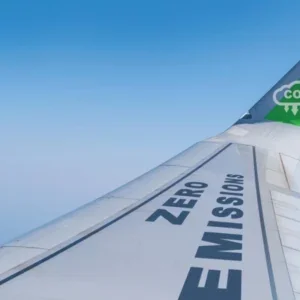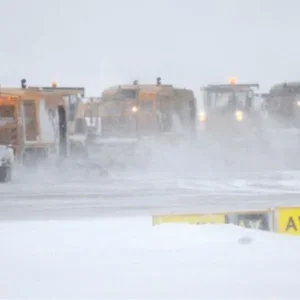Future Airport: What is the role of you and your team at Copenhagen Airport?
Inger Seeberg: I joined Copenhagen Airport (CPH) in 2006 and have been responsible for environmental affairs since 2010. The department handles all types of tasks, including noise, air quality, water quality, soil contamination, carbon emissions, waste, nature, land use planning and legal matters. It works closely together with other CPH departments, such as masterplanning; corporate affairs and legal; external relations; traffic; technical service and operations; in achieving CPH’s environmental targets. CPH also values working with its international counterparts.
Among other representations, I am currently a member of the ACI Europe environmental strategy committee and I chair the Nordic Initiative for Sustainable Aviation (NISA).
Please can you explain what CPH has done so far in the expansion process?
Masterplanning has developed a longterm capacity plan that outlines the optimal principles for expanding CPH. Having an overall plan and strategy in place means that the short-term projects can be carried out in line with these principles, making sure that they do not interfere with the long-term scheme.
In the past few years we have made the airport ‘A380-ready’ by widening the main runway (22L/04R), extending Pier C and building gates and stands that can accommodate that aircraft. Central security will be nearly doubled, the airside terminal will be expanded and the landside one reconfigured, and a new pier – E – is to be built.
Why is expansion required?
It’s necessary in order to attract and accommodate growth to CPH, the city itself and Denmark in general. In the past years, there has been a relatively high growth in the number of passengers: in 2015–16, it went from 26 million to 29 million.
The expansion will accommodate 40 million passengers a year, and also sets out principles that will enable the airport to accommodate up to 60 million passengers a year in the long run.
The airport’s vision is to “accommodate growth in a responsible manner”. What do you mean by that?
Having responsibility for an important piece of infrastructure, such as the country’s largest international airport, means taking responsibility for its effects on the surrounding environment and community.
A number of comprehensive programmes are already in place, such as noise and air quality monitoring, soil pollution, groundwater and wastewater quality, and much more.
The airport is also working according to the targets set out in our environmental and climate policy, which includes targets for CO2-emissions, energy savings and the handling of waste. Since 2014, CPH has been accredited level-three optimisation for airport carbon, which involves accounting for annual CO2 emissions, having an active CO2 reduction policy in place and engaging with third parties with regard to reducing their emissions.
The aim is that the expansion of the airport shouldn’t have an unnecessary impact on the environment. An environmental impact assessment (EIA) of the long-term expansion plan will be carried out. If the analysis shows any unacceptable environmental effects, ways to mitigate them will be sought.
The first set of noise calculations show that the expansion can be carried out within current noise limits. It can be completed within the current footprint of the airport, and no new runways are planned.
The number of destinations CPH flies to has increased. What has been done to combat the extra noise and air pollution?
First of all, it is important to note that increasing the number of destinations does not automatically increase noise or air pollution. Even though there has been a small increase in the number of aircraft operations from 2015 to 2016, the overall tendency during the past decade has been that the number of aircraft operations has either stagnated, or decreased simultaneously with the increase in the number of passengers.
This is caused by two factors. Firstly, airlines have become much more effective. The ability to fill their aircraft has increased dramatically, meaning that the same number of aircraft carry a higher number of passengers. This is good for the economy and the environment.
Secondly, larger aircraft have been introduced to the market and taken into operation by airlines. The Airbus 380, for example, is able to carry more than 600 passengers, and has a really good environmental performance, despite weighing more than 600t.
The generally positive development in the environmental performance of aircraft is caused by more factors, but the International Civil Aviation Organisation of United Nations (ICAO) has adopted even stricter environmental regulations that set out specific demands for airlines, and aircraft and aero-engine manufacturers. The newest regulations, agreed in 2016, include new standards for CO2 and particulate matter, as well as a carbon offset trading scheme for aviation.
Locally, a number of things are also being done to reduce pollution. A comprehensive rule-set exists on noise that applies to airlines and the air navigation service provider. Among other things, it involves 24/7 noise monitoring, flight corridors, rules for use of the runway system, a night-time noise threshold and rules for engine run-ups.
In terms of mitigating air pollution, the focus is on encouraging operators to use the most suitable procedures, such as environmental push-back, singleengine taxiing, and limited use of APUs – auxiliary power units – and so on.
Are there any areas in particular that you are focusing on in the expansion, such as runway security or departure lounges?
The expansion is in all areas – landside access, terminals, piers and stands, baggage, ancillary, and airfield. A particular challenge is the significant expansion of the apron area that is required to meet demand for capacity.
At the moment, the remaining areas on the main apron are being developed. Additional capacity can be provided by expanding it to the area currently occupied by the crosswind runway. As a result, the latter will have to be shortened and displaced.
You are redeveloping the airport in phases. Why is this?
The two main reasons for expanding the airport in phases are the ability to offer competitive charges and the flexibility to adapt to changes in the industry.
Airport expansions are costly, and CPH is able to offer competitive charges to the airlines by not having too much excess capacity. Implementation of new technology and process optimisations are very important to assist airlines and ground handlers to have low total cost of operations (TCO). Salaries are high in Denmark, and CPH must be at the forefront of technology implementation to remain competitive. Expanding in phases limits the physical constraint in installing new technology.
How will the airport run while the work is going ahead?
The airport will run in full and normal operation. Inconvenience to passengers, airlines and other customers will be as minimal as possible.
To what extent have other interested parties, such as airlines and shops, been involved in the process?
Interviews and surveys were carried out before the masterplan update started. In addition, strategic partnerships were formed with key airlines. The master plan and expansion of the airport are some of the themes dealt with in these strategic partnerships. Implementation of the master plan involves legislative changes and an update of the land-use planning framework, which is being discussed regularly with the authorities and other relevant parties.
With more passengers using CPH, how will better transport to the airport be secured?
CPH is already well connected to the capital city, Denmark and Sweden. The airport is connected by train, the metro, a number of bus lines, the highway and the Øresund bridge to Sweden. Passengers only need to spend 14 minutes on the metro to get to Copenhagen city centre, or 20 minutes by train to be in Malmø in Sweden.
These connections have led to more than 60% of CPH’s passengers using public transport modes (train, metro or public busses) to get to and from the airport. The aim is to hold on to these good results as the airport grows.
What has the relationship been like with the communities living near the airport? Have there been any calls for it to be stopped? If so, how have they been dealt with?
Relations with the local communities are generally quite good. With more than 23,000 jobs, the airport is seen as one of the most important workplaces in the local area. That said, knowledge and awareness of the expansion plans must be increased among the nearby communities. Questions about the expansion have been asked, but there haven’t been any protests against it.
Finally, what are the next steps in the expansion?
The Danish Government has been asked for its help in establishing an updated legal and land-use planning framework for execution of the full expansion plan, and this process is now beginning. However, as mentioned, a number of comprehensive projects are already under way for which the legal basis is in place.






